
Presto Testing Instruments, a company that focuses on developing and manufacturing testing equipment for the global packaging industry, has recently released their newest publication entitled "The Profitable Corrugated Box Code." The book is intended as an educational tool that can be used to prevent costly mistakes in corrugated box production. In this guide, readers will find information about how to understand and utilize CORRUGATED BOX TESTING which includes a list of tests and procedures for determining whether cardboard boxes are suitable for shipping and packaging purposes. This handbook provides valuable insight into how you can save money by avoiding losses due to poor-quality products or services through improved materials handling procedures.
You will also find information about how corrugated box testing is performed, what equipment is needed for testing, and who should be performing the tests thus, making it easy to understand packaging materials evaluations. The book provides information on CORRUGATED PACKAGING TERMS and is a must-read for those who want to know how corrugated materials are tested as well as what the differences between some of the tests are.
In order to choose or specify proper packaging material, it is essential that you know which test should be performed. Here, we will explain corrugated material testing. Corrugated Material Testing is highly appreciated in the packaging industry since it gives us extensive information about raw materials and products under investigation. In order to perform this test properly, you need to follow certain steps:
1) You should start with measuring the dimensions of the corrugated board, including height and width. You must use a digital caliper for this purpose. In order to avoid any discrepancies in results, you must mark the board during the measuring process.
2) You should also measure the weight of the corrugated board in grams. In this case, you can use a scale instead of a digital caliper. However, before using a scale, there are some factors that you need to be aware of:
You cannot use a scale if the board is wet.
3) In order to determine density and weight per unit area, you can use the following equations:
4) The volume of the corrugated box should be measured in three dimensions, i.e., width x height x depth or length x height x width.
5) The next step is to measure the thickness of the corrugated board. In order to perform this task, you can use a vernier scale with high accuracy. It is also possible to measure it with the help of calipers. The measurement should be taken at least in three points and the average can be calculated.
6) Now cut the corrugated board using a cutter and measure its four dimensions. You can use a ruler or measuring tape to take these measurements. They need to be compared with the diagram and the deviation should also be recorded.
7) Once all of these calculations are done, you can find out the total area of the corrugated board.
8) For corrugated board, the determination of breaking stress and modulus of rupture can be done using the following calculation:
9) You should take another scale and place it on top of the corrugated board, again measuring where it's placed first.
10) Again measure the height of the corrugated board. Place this scale on top of the same corrugated board. Weighing should be done in kilograms units as that is what the unit's conversion factor is. Read both scales simultaneously and take their measurements.
11) Take the second scale and place it on top of another layer of corrugated board. Weighing should be done in kilograms units as that is what the unit's conversion factor is. Read both scales simultaneously and take their measurements.
12) Repeat steps 10-11 until you have weighed all layers on top of one another.
You can also make use of several testing instruments like box compression tester, bursting strength tester etc. to measure the other aspects of corrugated boxes.
What equipment is needed for testing?
The CORRUGATED MATERIALS HANDBOOK lists down a set of equipment for testing corrugated boxes. It first lists the necessary equipment needed to complete a box stress test, then moves on to a set of equipment that should be used during a flute crush test. And because the flute crush test requires a lot more equipment, this would suffice for our list of what to bring when testing Corrugated Fiberboard.
How does this corrugated packaging book help in business improvement?
The CORRUGATED MATERIALS HANDBOOK is a reference guide for engineers, designers, manufacturers, and suppliers. They can pick the right corrugated material for their product based on its strength properties. This can reduce the cost of designing products, especially for products that require rework after being produced.
This book will certainly help the manufacturers to:
We know that corrugated packaging is used around the world for a wide range of applications, including shipping, storage, and distribution. As a result of this diversity, there are hundreds of corrugated products that can be selected by the end-user for different requirements.
The CORRUGATED MATERIALS HANDBOOK from Presto is a complete guide to the products, processes, and problems related to corrugated packaging. It brings together a wide range of information on all aspects of this versatile material, ranging from its history and manufacture to more specialized subjects such as automated loading systems for high-speed production lines. Thus, you can easily purchase this book available at

Get information about new product launches, research, innovation, and endeavors at Presto.